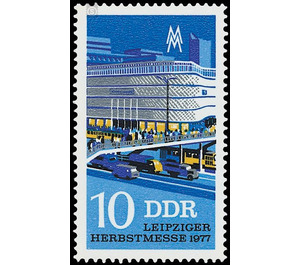Commemorative stamp series - Germany / German Democratic Republic 1977 - 10 Pfennig
Theme: Architecture
| Country | Germany / German Democratic Republic |
| Issue Date | 1977 |
| Face Value | 10.00 |
| Color | blue |
| Perforation | K 14 |
| Printing Type | Rotogravure 2 |
| Stamp Type | Postage stamp |
| Item Type | Stamp |
| Chronological Issue Number | 1992 |
| Chronological Chapter | GER-DDR |
| SID | 827936 |
| In 22 Wishlists | |
Leipziger Herbstmesse 1977 At the Leipziger Herbstmesse 1977, the Ministry of Posts and Telecommunications of the German Democratic Republic issues two multicolored special postage stamps. Special cancellation from 30th August to 29th October 1977 Leipzig Autumn Fair 1977 10 Pfennig value: Consumer department store Leipzig and pedestrian bridge at Friedrich Engels Platz In the center of the trade fair city of Leipzig, the famous trade street Brühl, was built on the grounds of the birthplace of Richard Wagner the department store Brühl. Extended in 1928 and burned down to its foundations by the effects of the war in 1944, after 1945 the house was rebuilt in voluntary working hours. In consumption "department store of the peace" was sold until 1950 only on the ground floor and on the first floor. The other misused premises were expanded until 1960 again as sales floors. In 1966, the growing supply tasks required the reconstruction and conversion of the "consumer" AM BRÜHL, which had been centrally managed since 1965 and ended in 1968, which at the time created the largest department store in the GDR with 11,000 square meters of sales room space and 1,600 employees. The cityscape was given a modern character by the attractive light metal curtain wall on the old building, the seven-storey new building, which is architecturally adapted to the residential building tract, as well as the ground floor low-rise building of the Kaufhalle. Since then, the department has been offering about 50,000 items, which are sold in 5O sales departments. About 58,000 visitors are registered daily. Friedrich-Engels-Platz is an important traffic junction of the Leipzig Promenadenring. As the northwestern corner of the streets surrounding the city center, it has a pass-through capability of 5,200 passenger cars / h for motor vehicle traffic. Important tram lines pass through this traffic facility. Due to the convenient location of the tram stops and the directly adjacent consumer department store, this transport hub, which was converted in 1964, is also a heavily frequented pedestrian traffic facility. In normal peak traffic, it is about 7,500 pedestrian / h, in trade fair traffic about 10,000 pedestrian / h. In 1972, the construction of a pedestrian bridge was to increase traffic safety and the safe management of pedestrian traffic. The urban design requirement for a structure as lean as possible was met by the choice of a flat, multicellular hollow steel cross section for the superstructure on slender single columns. The railings are designed as lightweight steel bar rails without stressed posts. The length of the bridge is 78 m with a width of 6 m. In 1977 the second stage of the pedestrian bridge system was realized by crossing the Dittrichring.


